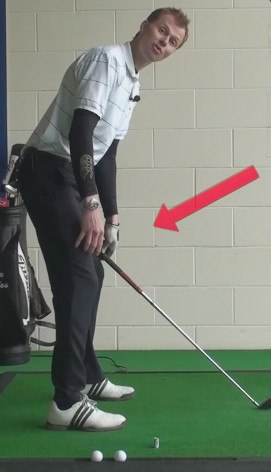
If you're experiencing contact on the toe of your golf clubs, it's important to evaluate your setup, swing, and equipment to address the issue. Here are some tips to help prevent toe contact and improve your ball-striking:
- Check Your Setup:
- Ball Position: Ensure your ball is positioned correctly in relation to your stance and the club you're using. For most full shots, the ball should be positioned just inside your left heel (for right-handed golfers). Adjusting the ball position can help promote a centered strike.
- Posture: Maintain proper posture by bending from your hips, keeping your back straight, and having your arms hanging naturally. This helps you maintain the proper distance from the ball and promotes a consistent swing path.
- Alignment: Check your alignment to ensure your feet, hips, and shoulders are square to the target. Poor alignment can lead to compensations during the swing, causing off-center contact.
- Swing Technique:
- Balance and Weight Transfer: Maintain good balance throughout your swing and ensure proper weight transfer from backswing to downswing. Proper weight transfer helps you maintain control and strike the ball more consistently.
- Swing Path: Pay attention to your swing path. If you're swinging too much from the outside-in (over the top), it can lead to toe contact. Work on swinging on a more inside-out path to promote center contact.
- Tempo and Rhythm: Maintain a smooth and balanced tempo in your swing. Rushing or swinging too aggressively can affect your control and lead to off-center strikes.
- Equipment Considerations:
- Club Length: If you consistently make toe contact, it might be worth considering getting your clubs fitted. An incorrect club length could contribute to inconsistent strikes. A professional club fitting can help ensure your clubs are the right length for your height and swing.
- Club Lie Angle: An incorrect lie angle can also result in toe contact. A club that is too upright can cause the toe to dig into the ground, leading to off-center hits. Consult with a professional to determine if your lie angles need adjustment.
- Club Grip: Make sure your grip pressure is not too tight. An overly tight grip can restrict the natural movement of your wrists and lead to inconsistent contact.
- Practice and Feedback:
- Practice Drills: Work on drills that promote centered contact. For example, try placing an alignment stick or a towel just outside the toe of the club at address and practice swinging without making contact with it.
- Video Analysis: Record your swing from various angles and analyze your contact point. This can help identify any swing flaws or compensations that are leading to toe contact.
- Seek Professional Guidance: If you're struggling to correct the issue on your own, consider working with a golf instructor. They can provide personalized feedback, identify swing faults, and offer drills or swing modifications to improve your ball-striking.
Improving your setup, swing technique, and addressing any equipment-related issues can help you prevent contact on the toe and achieve more consistent ball-striking. Remember to practice regularly and be patient with yourself as making swing changes takes time.
If you tend to make contact on the toe of the club, the first thing to do is check your equipment.
Shafts that are too long for your swing will cause toe contact, as will clubs that lie too flat (horizontal). Check this on a level surface, like a wood floor or asphalt path, by taking your normal stance; if the heel of your club is off the ground at address, the lie is too flat.
Provided your clubs aren’t the issue, it could be a simple matter of balance or ball position. If you lean back on your heels at address, or stand too far from the ball, toe contact is sure to ensue. Make sure your weight is evenly distributed between the heels and balls of your feet, and that your arms hang freely rather than reaching for the ball.
Experiment with ball position on the driving range until you find the sweet spot – the proper distance for your swing plane and path. It will be different with each club, but practice enough and it will become second nature before long.
If your setup is sound, look to your swing for the answer. Swaying off the ball, rather than turning the hips and shoulders, is a common cause of poor contact.





